1970s Triumph Stag

On the commercial vehicle front they owned the marques of Leyland, AEC, Albion, Daimler, Guy, Scammel, Thornycroft and Aveling-Barford.
|
Return to Appendix One Index
|
Notable Motor Manufacturers in Britain
This section is being revised. Once the details are complete the entire section will be re-written to bring it into some kind of order. For illustrations of period-specific vehicles, more unusual designs and a discussion on the changes in styling see App 1 Private Motoring - Motorbikes, Scooters and Cars
Thanks are due to Barry Ruck (a regular contributor to the alt.binaries.images.vintage-engineering newsgroup) and to Ian Johnston, Dave Plowman, Geof Mackenzie and Mike G (all contributors to the uk.rec.cars.classic newsgroup). Thanks also to Tim Whyte, who supplied several scanned images taken from adverts in his collection of old magazines.
Leyland Motor Corporation/British Leyland
The Leyland Motor Corporation was formed in 1963, based on the established commercial vehicle manufacturer which had over the years acquired several motor car companies.
The name changed to British Leyland in 1968 when Leyland Motors, British Motor Corporation and Jaguar merged into a single large company. This new company incorporated many famous names, including Austin, Morris, MG, Wolseley, Jaguar, Daimler, Rover and Triumph.
1970s Triumph Stag

On the commercial vehicle front they owned the marques of Leyland, AEC, Albion, Daimler, Guy, Scammel, Thornycroft and Aveling-Barford.
In 1971 the Leyland Motor Co formed the core of a general amalgamation of the motor car and commercial vehicle industry named British Leyland, set up under the auspices of the National Enterprise Board to try and help British firms compete with the larger American and German firms.
Things did not go entirely according to plan however, within the first few years British Leyland's share of the British market had fallen from over thirty percent to less than twenty. The government appointed a South African by the name of Michael Edwardes to re-organise British Leyland, and he set about closing down the out lying plants established in the development areas to concentrate on the main hub in the Midlands.
In 1972 the British motor industry produced over two million vehicles, an all time record but the Austin Allegro introduced in 1973 was a failure. There were rumours of technical problems, although all the people I have spoken to who owned one said they were fine, but the styling failed to catch the publics imagination (including the unusual squared-off steering wheel). The example shown below is the 1500cc Vanden Plas luxury version, by this time the problems of chromed metal rusting had seen chrome fall from favour and this car has only the chromed radiator grille and bumpers.
1973 Austin Allegro
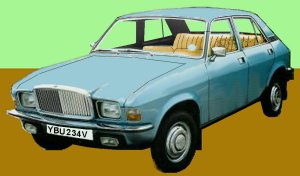
By 1975 British Leyland had run into serious financial difficulties and the government acquired a 98% share in the company. In 1978 the name changed to BL and the organisation was broken down into four divisions (Cars, Trucks & Buses, International and Special Projects).
In 1983 BL (by now trading as Austin Rover) introduced the Maestro, the first car with a `talking dashboard' that alerted the driver to problems. During this decade financial difficulties lead to co-operation with Honda, Rover cars then appeared with Honda engines, which did little to endear the brand to the public.
Leyland Bus and Truck division merged with the Dutch DAF company to form Leyland DAF in 1987, this failed in 1993 and the Leyland operation was taken on by a management buy-out.
The company was subsequently privatised and the motor car division operated under the Rover Group name until 1994 when the company was sold to the German firm BMW (Bayerische Motoren Werke AG). In 1998 the new Rover 75 (really more of a BMW but with Rover wood and leather interior) was released but failed to catch on. BMW sold what remained of Rover to investors for £10. The firm, now trading as MG Rover was this was still providing employment for over 30,000 people in the West Midlands.
MG ZR sports saloon
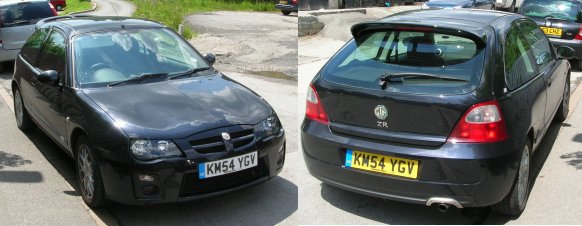
The MG Rover 'City' Rover of 2003 was actually made by Tata of India, this again failed to sell and in 2005 the firm closed. What was left was purchased in 2007 by a Chinese motor manufacturer looking to expand into the European market.
Rover Cars
The Rover Cycle Company was set up in 1884 and established a reputation as a bicycle manufacturer based in Coventry. Rover were already branching out into motorcycles when they started building cars in 1904, in 1906 they changed their name to The Rover Company Limited. Rover merged with Lanchester in 1930 but kept both the Rover and Lanchester names. Rover and Lanchester had good reputations for making well-built cars for the upper end of the market.
1908 Rover 'Lauaulette'
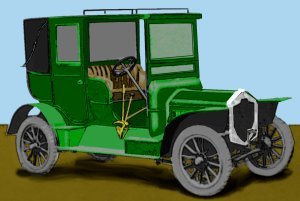
The photos shown below were taken by Ian Mackay in 2007, Barry Ruck (a regular on alt.binaries.vintage-engineering) advised on the model and date of introduction.
Pre-war Rover 12 HP Sports Saloon, this one registered in 1935
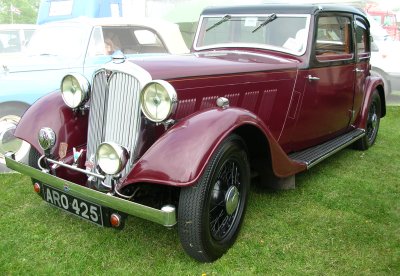
The Rover P4 proved itself a classic, introduced in 1950 the last were built in 1964. There were several variants, featuring larger engines and more 'add-ons', I believe this is the 110 version.
The Rover P4 post-war saloon, this one registered in 1963
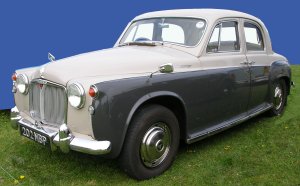
The Rover P5 was another classic, introduced in 1963 the last were built in 1973, Harold Wilson and Margaret Thatcher both favoured these when they were Prime Minister, with its luxury leather and wood interior and top class carpets it was known as 'the Gentleman's Club on Wheels'. This car started life as a two door saloon but the four door coupe variant was the motor of choice for the wealthy in the 1960s and early 1970s.
The classic Rover P5, this example dating from 1972
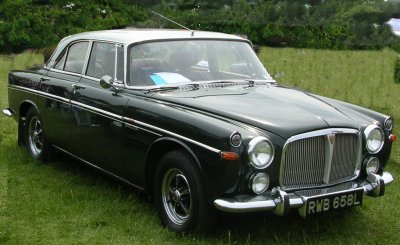
In 1952 Rover's gas-turbine car set a speed record of 243 kph/152 mph.
Rover produced a number of exceptional cars, notably the very successful Rover 2000 P6 (first produced in 1963) shown below, which remained in production into the BL era, production ending only in 1976.
1960s Rover 2000 P6 saloon
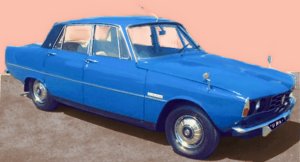
In 1967 Rover was bought by Leyland (see Leyland Motor Corporation/British Leyland above).
Landrover(1948, sold to BAE in 88, sold to BMW in 1994, sold to Ford in 2000, for sale in 2007)
The Landrover (built in Sollihul) was something of a surprise success but its origins are even more surprising. In the 1930s the American arm of Austin developed a 'light car' for possible use by farmers, the prototype actually appears in a Laurel and Hardy film where it was on trial by the US Army. The US military wanted the vehicle but the US government wanted it built by a US firm, in the event several firms became involved including Ford and Wilies and this vehicle became known as the Jeep. In the second world war vast numbers of Jeeps were produced. After the war the British motor industry was faced with steel shortages and fuel rationing, however aluminium production had increased during the war and Rover decided to try building a prototype aluminium bodied farmers truck on a jeep chassis. This proved a successful combination and they decided to produce a vehicle for agricultural use. They called the aluminium 'Burmabright' (as the pressings were made in Birmingham). The vehicle had numerous power take off points, making is a handy light tractor for agricultural use and proved to be a particularly robust design. The army adopted the landrover as its standard light truck in the later 1940's and production of the civilian and military versions had trouble keeping pace with demand. The windows in the doors were in two parts, the rear half could slide forward to allow hand signals, the windscreen could hinge down to lie on the bonnet in which position it could be moved to the side and removed completely. The doors, when opened fully forward, could be lifted off to provide easier access and a simple drop-down tail-gate was fitted, supported by chains when open to form a platform. The photo below shows the original Mk 1 type, all of which (from memory) were in a plain green with dull aluminium trim around the windows and a dull metal grille on the front covering the radiator (and on early examples the headlights as well).
The original civilian machines were produced in a light apple green, these are now very rare beasts, this changed early on to standard military bronze green.
Fig___ Original Landrover (Series One) in the original colour
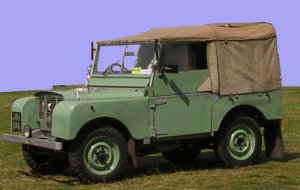
Fig___ Original Landrover (Series One) in 'bronze green'
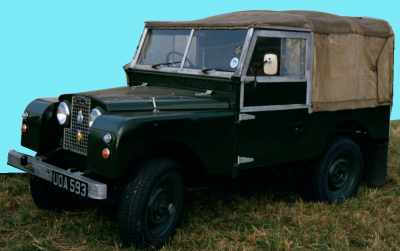
The Series II was introduced in 1958, followed by the IIa in 1961, these models had a moulded curve to the upper body side but retained the headlights on the radiator panel. The surprising scale of civilian demand for the landrover meant it had to keep pace with legislation on matters such as lighting. In 1968 Series II Landrovers for export had the headlights moved to the wings, this carried over to domestic models in 1969. The Series IIa continued in production until 1971 when it was replaced by the Series Three.
Fig___ Series III Landrover
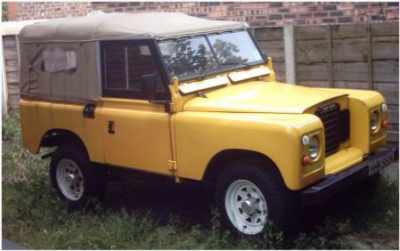
The Army made extensive use of the Landrover but found it was not heavy enough for some tasks so Landrover built the '1 ton Forward Control' model, with the driving position moved right to the front and a large cargo bay behind. First seen in 1961 the original design had a rather curved shape to the cab but was not a success. The later models, introduced from 1966 (based on a Series IIb 109" long wheelbase chassis lengthened to give a 110" wheelbase) had a more angular cab and proved a very handy machine widely used by the military but was unsuccessful in the civilian market. The example shown below was photographed at the Tatton Classic car Show in 2007 alongside a second world war jeep.
Fig___ One ton Landrover
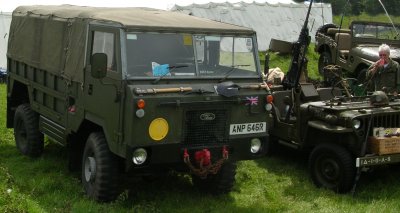
The military adapted landrovers for a range of duties, allowing a single collection of spares to service a range of vehicles. One common adaptation was the small fire fighting appliance, the example shown dates from the early 1950s and was based in a factory, but the military used similar vehicles at their outlying bases (see also Appendix One - Public and emergency services - Emergency Services).
Fig ___ Landrover based industrial fire engine
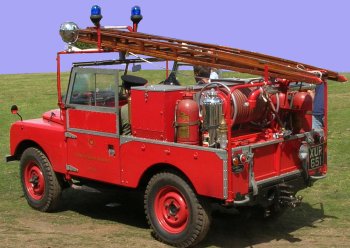
Fig ___ Landrover towed fire fighting pump unit

Lanchester (1895-1951)
Frederick Lanchester had a background in draughting and in engine design when he built the first British motor boat (using an engine of his own design) in 1893. He is widely regarded as something of an unrecognised genius, many of his ideas, considered impractical at their inception, subsequently became standard practice. He decided that the existing continental motor cars were too close to their bicycle and horse-drawn carriage origins and designed a car working from basic first principals. This appeared in 1895 and was Britain's first successful four wheeler car. He introduced the epicyclic gear (forerunner of the automatic transmission) in 1896. Lanchester Cars set up series production based in Birmingham in 1901, the company merged with Rover Cars in 1930 but the Lanchester name was retained. The example shown below is a Lauaulette, which means it has a fold down hood at the rear of the passenger compartment.
1923 Lanchester 'Lauaulette'
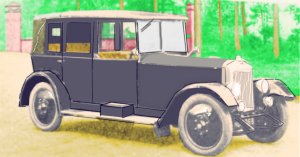
The name Lanchester was dropped by Daimler in 1956 almost 60 years after the first one was built.
British Motor Corporation (1952-1968 then part of British Leyland) - Included Morris, Austin, Wolseley, MG (which stands for Morris Garages), Riley, Jaguar
Formed in 1952 when Morris and Austin merged this was at the time the fourth largest motor manufacturer in the world. Both these firms had already absorbed many smaller companies and for some time they continued selling cars with their own in-house brand names such as Wolseley, MG (which stands for Morris Garages), Riley and other marques. These were in fact often the same car with minor differences in their body work and radiator logo. The example shown below could be either a Morris Oxford or an Austin Cambridge, I understand that this car is a Cambridge of 1959. In the style of the time there is a lot of chrome trim including the wing mounted rear view mirrors (A), the stirps along the side (B) and around the tall rear light assemblies (C). There is also a silver strip around the front headlights and the radiator grille and front and read bumpers (D) are also silver.
BMC 'Morris' Oxford or 'Austin' Cambridge with typical mid to late 1960s styling

Dave Plowman was able to advise
The Farina Austin Cambridge and Morris Oxford had identical engines and mechanics as well as basic bodies. The previous generation Cambridge and Oxford also shared engines and much of the mechanics - only the bodies were different.In 1959 BMC introduced the Issigonis-designed Mini Minor. Revolutionary in many ways, with front-wheel drive, transverse engine, and independent rubber suspension, this proved to be a classic design and the Mini remained in production until 2000.
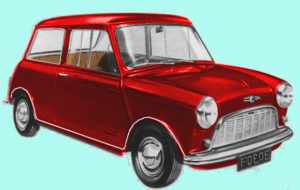
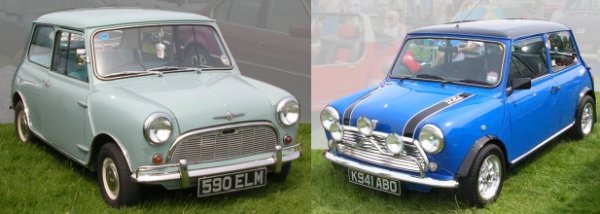
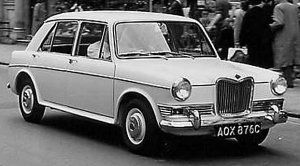
Jaguar joined the group in 1966 and BMC merged with Leyland in 1968.
Wolseley
The Woseley Tool and Motor Car Co Ltd were based in Adderly Park, Birmingham, the company grew out of the Woseley Sheep Shearing Machine Company after Herbert (later Lord) Austin who had a share in the company used the factory to build a series of experimental cars in the 1890's. By the turn of the century Woseley were the biggest manufacturer of motor cars in Britain.
1934 Wolseley saloon
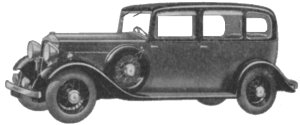
Mr. Austin set up a factory under his own name at Longbridge in 1905 but retained the Wolseley name as well. In 1927 W R Morris bought Wolseley Motors Ltd of Birmingham from the liquidators and formed Wolseley Motors (1927) Ltd (the (1927) is dropped from the company's name in 1935).
1965 Wolseley saloon
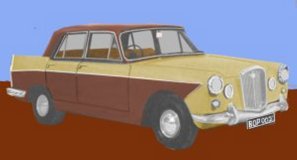

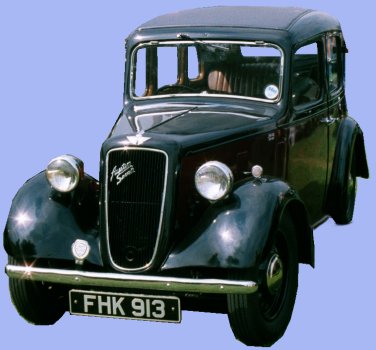

Austin Healey (1953-
Mr Healey used Austin parts to build a series of two seater sports cars, the most famous of which was probably the Sprite (known as the 'Frog Eyed Sprite' because of the headlamp mounting) introduced in 1958. The picture (courtesy Tim Whyte) is from an advertisement of the period.
Austin Healey Sprite
![]()
The Austin Healey marque became part of Austin and thence the British Motor Corporation but the cars were built at the MG factory near Abingdon in Oxford. The Austin Healey 3000 Mk2 shown below dates from 1963.
Austin Healey 3000 Mk2
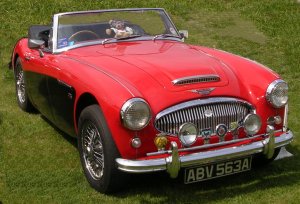
Morris Motor Co. (1912- 1952)
Founded by William Morris, Viscount Nuffield (1877-1963). Morris started making bicycles at 16 with capital of £4; designed motor cycles and in 1912 he produced the £162 Morris-Oxford car which made a considerable stir at the Motor Show. The illustration below is courtesy Tim Whyte, it was taken from a Morris document produced just before the Second World War.
1912 'Bullnose' Morris Oxford
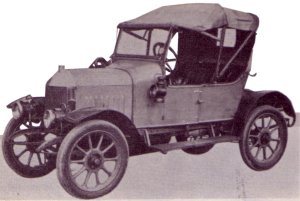
The firm acquired property in Cowley for expansion, the Cowley factory produced mainly munitions during 1914-18 war. Morris Motors Ltd. incorporated 1919 and produced 50,000 cars a year. Morris went on to produce the Morris Cowley with its bull-nosed radiator (often referred to as the Bull-Nosed Morris), there was a delay due to a shortage of engines after the First World War but series production began in 1919. Morris was among the first to follow the Ford model of assembly line production and Morris Motors became one of the largest motor companies in the country. In 1926 Morris divided the business into the Pressed Steel Company, Cowley, and Morris Motors (1926) Ltd., the former specialising in building pressed metal body parts for Morris and other firms.
1930 Morris Six

The well known Morris-Minor appeared in 1931 and Morris acquired Wolseley and MG motor manufacturers and the SU Carburettor companies. In 1935 the Morris 8 appeared, in both open top (as shown below) and four-door saloon variants. In about 1936 a van variant was introduced as well. This design proved a winner and production continued for many years, with gradual improvements made to the engine, transmission, brakes and suspension.
Morris 8 Series 1 Tourer (c 1935)

The Morris 8 Series E of 1938 is typical of the era with its semi-streamlined body (notably around the radiator) and pressed steel wheels in place of the earlier spoked type. First produced in 1938 production was discontinued during the war but manufacture resumed after the war from '46-'48. The example shown is a pre-war type, after the war the headlights were altered to a more upright design allowing the use of standard headlamp bulbs. Mike G was able to advise -
Quite advanced for it's day in not having running boards. Plus it had a hydraulic brake system, which was not that common at the time. Still had suicide doors (hinged at the rear) though. :-)

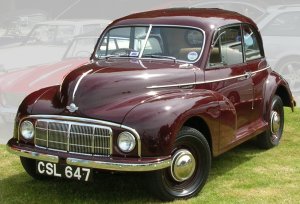

MG (Morris Garages 1924-?)
The photo shows an MG sports car from about 1933, the styling was typical for this type of car.
MG sports car from the early 1930s
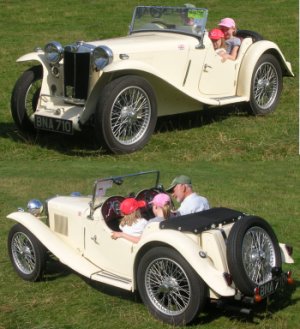
The MG-A produced from 1955 to 1962 was never very popular although it did well in racing.
MG A Type
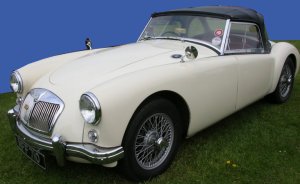
The examples shown below are the MGB, in production from 1962 until 1974 (when the bumper changed to black plastic and the grille changed from the traditional MG styling).
1973 MGB sports car
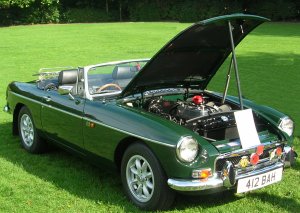
MGB GT
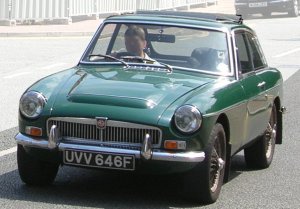
SS (1932-1945) and Jaguar Cars (1945-1966 then part of BMC)
Founded by William Lyons who began by building Swallow motor-cycle side-cars. In 1922 he extended the business and changed the name to Swallow Sidecar and Coach Building Company making body work for Austin Swallow and Morris Cowley Swallow cars. This change saw the firm move to a larger works in Coventry and the development of their own motor car designs, marketed as SS Cars (built using parts supplied by the Standard Motor Company, discussed below). In 1935 the first Jaguar car appeared but during the Second World War the factory manufactured spare parts for bomber and fighter aircraft. In 1945 the firm's name changed to Jaguar Cars Ltd. and they launched the XK120 which performed well in several races. The XK 150 was another successful design, the photo below was scanned from a magazine advertisement of the period, courtesy Tim Whyte.
1957 Jaguar XK 150 fixed head coupe
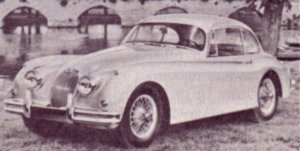
Jaguar Mk 2 Saloon circa 1962
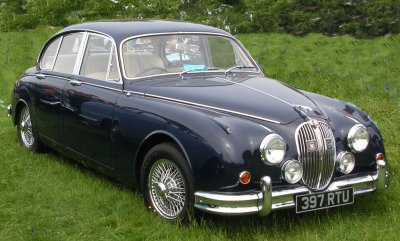
Jaguar acquired Daimler Company in 1957 or 1960 (sources differ on the date) and in 1960 they purchased Guy Motors of Wolverhampton and Coventry Climax Engines Ltd and in 1961 they introduced the classic Mk 10.
Jaguar S-Type (powered by the Jaguar XK engine)

In 1966 Jaguar was acquired by the British Motor Corporation Ltd. and in 1967 they produced the Jaguar E-Type sports car. The original design had glazed over headlight enclosures, however due to a change in the law in the USA the front had to be redesigned not to use these and the resulting water collection and rust problems earned the car a bad reputation.
Original Jaguar E-Type
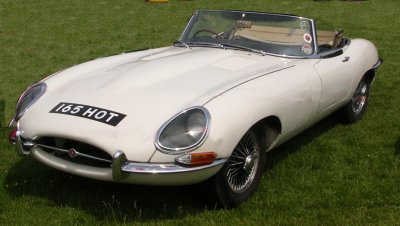
It remained a classic of its time however and remains a popular collectors car today. The example shown below was photographed in 2007 when I gather it was still in everyday use.
1960s Jaguar E-Type

1968 Jaguar Saloon

In 1968 BMC was merged with Leyland Motors to form British Leyland.
In the later 1980s Jaguar was purchased by Ford and the X type used a standard Ford engine (earlier Jaguars were essentially cars built around a Jaguar engine). The example below is the X type of 2003, a perfectly good car but the marque now refers more to the body styling than the engineering.
Fig___ Jaguar X type introduced in 2003
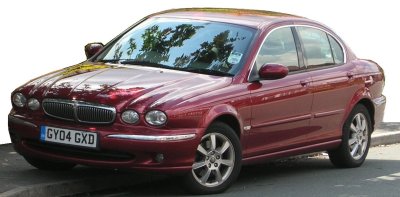
Standard Motor Co (1902-1962)
The Standard Motor Company was set up to build motor cars, the first machine rolled off the production line in 1902. They specialised in the lower end of the market, building low cost low maintenance vehicles. The company prospered and in the 1930's supplied the parts to a tycoon called William Lyons to build his SS or SS Jaguar cars, a partnership that lasted until after the Second World War. Jaguar went on to build their own cars, using the high powered XK series engine.
1948 Standard Vanguard

1960s Standard Ensign
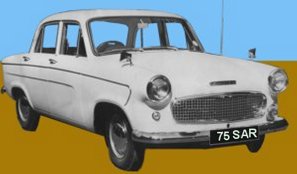
In 1944 Standard Motors bought what remained of Triumph and went on to build several cars using the Triumph brand (notably the Triumph Herald and Vitesse) as well as a number of fairly successful designs under their own brand.
Triumph TR6 Sports Car
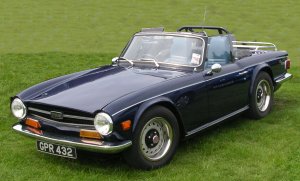
The Standard Motor Co built tractors for Harry Fergusen at their Coventry (Banner Lane) plant from the 1940'S but they withdrew from the arrangement in 1959, by which time tractor firm was called Massey Harris Fergusen.
Standard Triumph was purchased by Leyland Motor Co in 1962 (the Standard marque was dropped in 1963 as the meaning of the word in general culture had changed from implying quality to suggesting ordinary).
Triumph Motors (1923-1944 then part of Standard Triumph)
This firm grew from a motorcycle manufacturing business, based in Coventry. They produced their first motor car in 1923 and the popular Super Seven appeared in 1927. They standardised on the locally produced Coventry Climax engine and things went well but in the 1930's they hit hard times, the motor cycle business was sold off in 1937 but even so they went bankrupt in 1939. Triumph spent the war years under the ownership of Thos Ward Ltd, a Sheffield engineering firm, then in 1944 they were bought by Standard Motor Company. The Triumph name was retained and several successful designs bore the name including the popular Triumph Herald of 1959.
Triumph Herald

Rootes Group (1919-1967 then Chrysler UK) - Included Singer, Humber, Hillman
Set up by William Edward (first Baron) Rootes (1894-1964) who had been apprenticed to Singer Cars at Coventry and started a motor business with brother Reginald (Claud) in 1919 (Billy Rootes actually purchased 50 Singer cars which he sold at a profit, giving him the capital to start his empire). The firms headquarters moved to Devonshire House, Piccadilly in 1926. In 1929 Rootes acquired the Hillman and Humber factories in Coventry, and went on to build the Humber Snipe and Hillman Wizard. The Hillman Wizard of 1930 was not an outstanding success but 1932 saw the introduction of the Hillman Minx which was to be produced in various marks over four decades.
1939 Hillman Minx
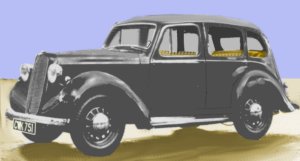
The name was changed to Rootes Group in 1931 and as business prospered Rootes took over other firms, including the French owned Sunbeam Talbot Motor Car Co. Ltd. (in 1935) and Singer Cars (in 1955).
The 1952 Hillman Minx shown below is typical of the period, the photo was scanned from a magazine advertisement of the period and tinted by Tim Whyte.
1952 Hillman Minx

The Sunbeam Talbot shown below is also a typical 1950s shape heavily influenced by American tastes as the USA was a major export market for British cars.
1957 Sunbeam Talbot Mk II
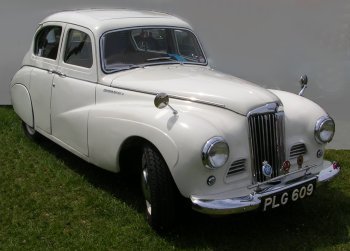
Early 1960's Hillman Super Minx
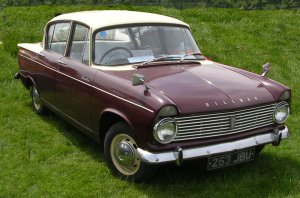
Sunbeam Alpine
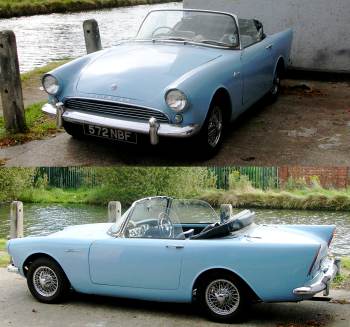
In 1963 a new plant opened at Linwood in Scotland to produce the new Hillman Imp, this proved a financial error and the firm was forced to obtain additional capital from the American firm of Chrysler. The Imp proved a popular car, with the rear mounted engine well tuned it proved rather more 'sporty' than the designers intended, although it did then require some weight (usually cement) in the front to keep it on the road.
Hillman Imp of 1963
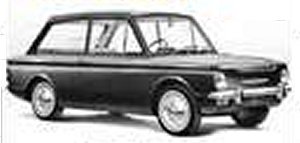
In 1967 Chrysler gained full control of the company and in 1970 the name changed to Chrysler UK Ltd although cars were still marketed as Hillman, Humber, Sunbeam and Singer. The use of the Humber name ended in 1976 when the Humber Sceptre ceased production.
Hillman Avenger early 1970s.

Humber & Hillman (1899-1929, then part of Rootes Group)
Humber was set up by Thomas Humber in Sheffield in the 1860's this bicycle firm opened factories in Coventry before switching to motor cycles (1895), tri-cars (1896) and finally four wheeled motor cars (1899). The Humber factory was one of the first to make aero engines during the Great War and afterwards a series of small cars was offered, but later models were within the 12 to 24 hp range which was the mainstay of the Humber business. They urchased the commercial motor manufacturere Commer Cars Ltd in 1926 and then merged with Hillman and thence joined the Rootes Group in about 1930. The Humber name continued in use into the mid 1970s.
1934 Humber Snipe 80 from an advert of the time
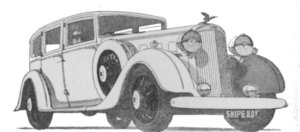
Hillman was another of the successful bicycle makers based in Coventry, they built their first motor car in 1907. In 1926 Humber Cars bought the London based Commer commercial vehicle company (which renamed its Centaur Company (founded in 1911) as Commer Cars Ltd. Later, during the 1930s, Commer would draw on some of these historic names for their new range of vehicles, such as the ‘Centaur’ or ‘Raider’.
In 1928 Hillman merged with Humber Cars, the first joint effort by the new company being the Hillman Wizard of 1931, by which time \Hillman Humber was itself merging into the Rootes Group.
Singer
Another bicycle manufacturer based in Coventry. They switched to motorbikes and three wheeler 'tri-cars' in 1901 and began making motor cars around 1904. The photo below shows their first model, produced in 1904 (photo courtesy Tim Whyte).
The first Singer car of 1904
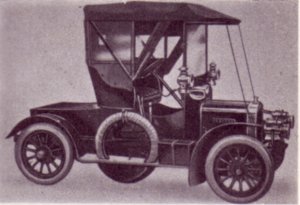
Singer cars went on to be very successful in trials at Brooklands and elsewhere. In 1914 the Singer 10, a small 100cc motor car, appeared and sold well. In the 1920s Singer expanded their base in Coventry and opened a motor car factory on the outskirts of Birmingham and, for a time, prospered. By the end of the 1920s Singer was the third largest British car manufacturer (behind Austin and Morris) but they ran into problems in the 1930s. They tried to join Rover in the mid 1930 but were refused and had to reorganise themselves as Singer Motors.
1950 Singer 1500 saloon
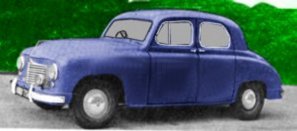
Singer were bought by the Rootes Group in 1955, on the understanding that the name would remain in use (the name was used for a version of the popular Hillman Minx). The name remained in use after the take over of Rootes by Chrysler i 1967 and the last 'Singer' cars were built in 1970. Chrysler formally dropped the name in 1971.
Sunbeam (1899-1935)
This company started as a tinplate manufacturer, producing cars from 1901. They teamed up with the French owned Talbot Darracq in 1920 and achieved some racing success. The Sunbeam factory was in Wolverhampton whilst the Talbot works was in London. Sunbeam supplied the engines for the ill fated R38 airship (6 Sunbeam Cossack III V12 engines, the engines were not at fault when the machine crashed).
The group was bought by Rootes in 1935 and the name was phased out, returning later under Rootes ownership as Sunbeam Talbot. The photo below is courtesy and copyright Ian Mackay.
Fig___ Sunbeam Talbot
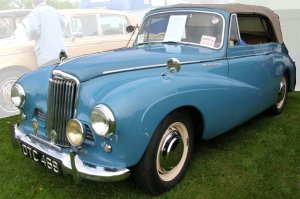
Sunbeam then ended up as part of Chrysler, the Sunbeam name was dropped in 1976 (other than for a brief revival as the Chrysler Sunbeam, a hatchback introduced to replace the Hillman Imp). Chrysler then sold off its European operation to the French Peugeot in 1978. Peugeot needed a new name for their fresh acquisition, Peugeot adopted the Talbot name (which had been dormant since 1959).
Rolls Royce (1904-?)
Mr. Royce, an electrical engineer (responsible for the pioneering electrical street lighting scheme in Liverpool in 1882. He set up his own company in Manchester to make electric cranes and dynamos. He bought his first car in 1904 and was not impressed, he was looking for ways to expand his business during the slump that followed the Boer War and decided to investigate the motor trade. The motor car was in great demand at the time, there were only about 8,500 cars on the road, the technology had reached a stage where they were practical and the infrastructure of petrol stations and garages with trained mechanics was becoming established. By the end of the year he had produced his own design of car and Mr. Rolls, an engineer and car dealer, had gone into partnership with him.
Fig___ 1905 Rolls Royce Motor Car
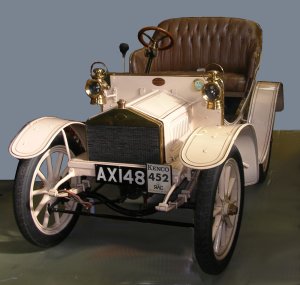
In 1906 the name changed from Royce Motors to Rolls Royce with the familiar RR logo (the letters were red until
1930 when they changed to black), the photo above shows a car built before this logo was introduced. In 1907 the firm set up a new factory in Derby and a Rolls Royce Silver Ghost was driven back and fore between London and Scotland for 40 days, covering 14,000 miles before it required a service. This gave Rolls Royce a reputation for reliability and build quality that it retained throughout the 20th century. In 1931 Rolls Royce bought the bankrupt Bentley Motor Ltd. In later years the Bolls Royce and Bentley motor cars shared the same body, the cars differing in interior styling and engine.
The example shown below dates from either the 1920s or 1930s (I am not sure which)
Fig___ Rolls Royce 40-60HP 6 Cylinder Touring Car
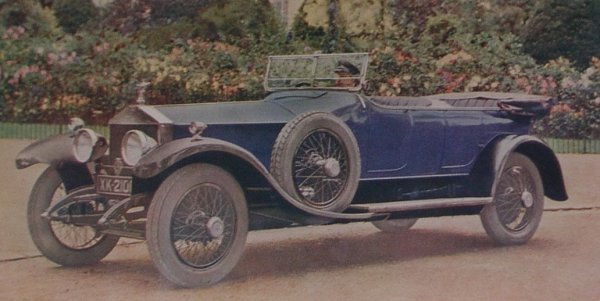
Rolls Royce are probably best known for their luxury saloon cars, much favoured by Royalty and the rich. The example below dates from the mid 1940s, at which time the driver was still expected to be a chauffeur, who had little protection from the elements.
Fig___ Rolls Royce Silver Wraith of 1946
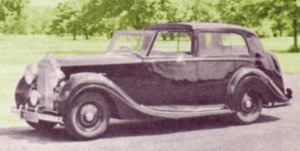
Rolls Royce were in the aero engine business from well before the second world war, their twenty six litre Merlin engine powered bombers like the Lancaster, fighters like the Hurricane and Spitfire and allowed the American Mustang to reach Germany, providing cover for the American daylight bombing raids. The aero engine side of the business is based in Crewe in Cheshire and was a world class competitor. In 1970 there was a big problem with their new RB211 aero engine which forced the company into bankruptcy and the government became involved and took over the company. In 1973 the motor car business was separated from the aero engine business and sold back into the private sector.
Fig___ Mid 1970s Rolls Royce
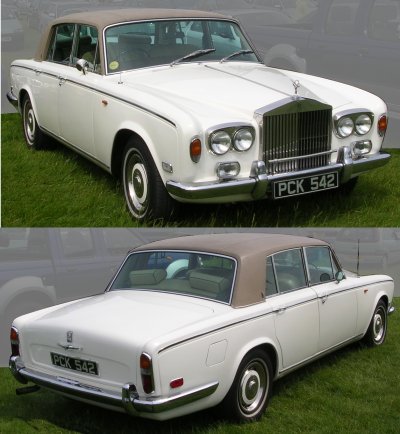
In 1980 Rolls Royce Motors was bought by Vickers Engineering (their first involvement in motor cars since they sold their interest in Wolseley to Morris in 1926). In 1998 the Rolls Royce motor car company was again sold, this time to the German company BMW.
Fig___ 1990s Bentley Continental
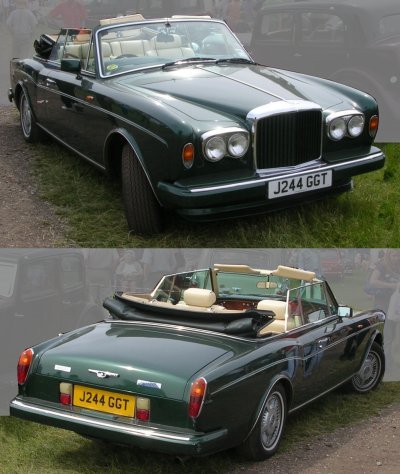
Morgan (1910-date)
Based on Worcestershire this company produced a series of fast three wheelers, they favoured the air cooled JAP V-twin motorcycle engine,instantly recognisable as it was mounted transversely across the front of the car. The example below is typical of the breed, it was these cars that first secured Morgan's reputation as a sports car maker, this particular machine has a Matchless rather than a Jap engine, but the engine is still a V twin and otherwise the machine is unaltered.
Fig___ Morgan three wheeler
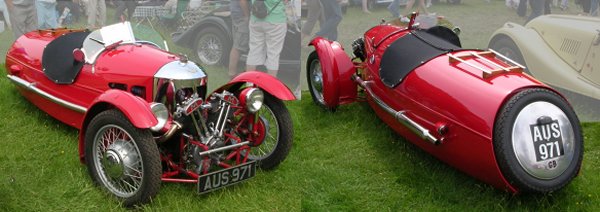
Morgan were the first company to employ independent front suspension. Not all their cars used the distinctive V twin engines however, the F4 shown below uses a water-cooled in-line engine, by the time this machine was built in 1937 the firm were also building four wheeled cars.
Fig___ Morgan F4 of 1937

Note the GB sticker on the rear of the Morgan, this type replaced a solid metal plate similar to the motoring club badges (but always mounted on the rear of the car) in the 1970s. The earlier type I remember from the 1950s were a black oval plate with GB in white on them, this changed to a thin white metal plate with black GB in the 1960s and the stick-on type appeared in the 1970s. See also Road Traffic - Introduction, Licensing, Wheels, Suspension, Brakes and Gearboxes for the historical background.
From the 1930s, with increasing competition from the likes of MG, they also produced four wheeler cars (the first four wheeler was introduced in 1932). Although noted for building fast two seater's they did produce some four seater's. As unashamed sports cars the Morgan retained lightweight spoked wheels into the 1950s, this kept the unsprung weight down, improving handling at high speeds.
In the 1960s Morgan produced a 3.5 litre car they called the +8, one of the fastest cars ever built (out performing the likes of the much later Porche 911) but retaining the original Morgan front suspension.
Fig___ Morgan four wheeler from 1983
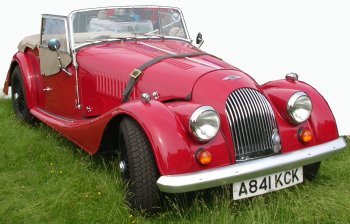
In 2001 Morgan produced the Aero 8, a thoroughly modern Morgan with a 4.4 litre engine and (finally) an entirely new suspension system, the marketing calls it 'the last real sports car'.
Armstrong Sidley (1919-1960)
Armstrong Sidley
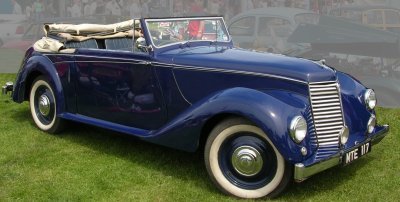
Never a mass production company they had a reputation for good design and build quality, typically they produced a thousand cars a year.
1960 Armstrong Sidley 'Star Saphire'
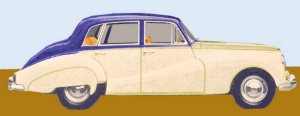
Jowett (1906-1954)
This Bradford based firm started out as a rather local supplier but expanded to address the national market after World War One. The Jowett range were all well powered and did well in competition racing.
1933 Jowett 'Flying Fox'

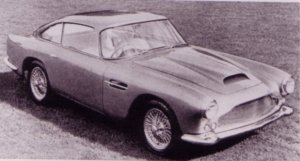
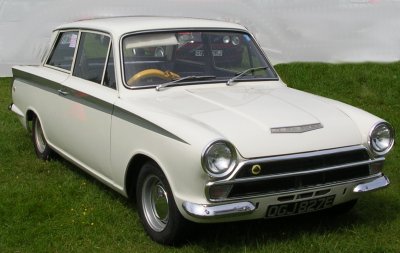
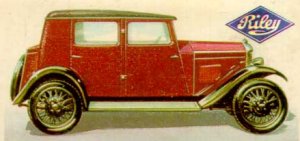
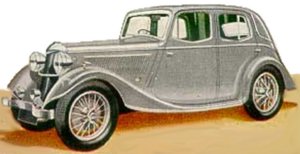

Crossley (1904-1937 after that they only built commercial vehicles)
This firm, based in Manchester (actually at a place called Gorton), started as an engine maker before going into motor car production, they were noted for building durable and reliable cars.
Napier
The Napier company was established in 1901 when they opened a factory in Acton Vale and in 1904 they produced the first successful six cylinder car. The firm ceased making motor cars in 1925 and instead produced aeroplane engines.
Alvis
Established in Coventry in 1920, as well as a successful range of motor cars they were heavily involved in aero engines, especially during the First World War, and in the late 1930's moved into light armoured vehicles.
1930 Alvis saloon

In the post war period they continued to build motor cars and armoured vehicles, the example below is a TA 21 Drophead Coupé introduced in 1952.
Post war Alvis saloon (this one registered in 1952)
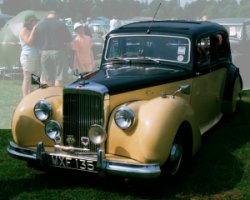
Alvis was bought by Rover in 1965, and hence became part of British Leyland, the last Alvis badged car was produced in 1967 (the 1965 Alvis TE 21). Alvis was then purchased from Rover by United Scientific Holdings plc in 1981, in 2002 Alvis merged with part of Vickers Defence Systems to form Alvis Vickers which was purchased by BAE Systems in 2004. The Alvis name is probably best known these days for the 1950s S series wheeled military vehicles (Saladin, Saracen, Stalwart and Salamander) and the 1970's tracked 'Scorpion' series (Scorpion, Scimitar, Sapper, Samaritan, Sultan and Striker). The distinctive Alvis badge was dropped in about 2004.
Daimler 1896 - 1960 (then part of the Jaguar group)
In spite of the name this was a wholly British company with no direct connection to the German firm Daimler Benz. The Daimler Motor Sindicate Ltd was set up in Coventry in 1896 to licence build cars based on Daimler patents. In 1904 the name changed to Daimler Motor Co and in 1910 to Daimler Co. They had a range of large heavy, quiet and sedate luxury cars, much favoured by the Royal Familly. Jaguar acquired Daimler Company in 1957 (or 1960, sources differ on the date) and in 1966 Jaguar was acquired by the British Motor Corporation Ltd. In 1968 BMC was merged with Leyland Motors to form British Leyland.
Daimler Double Six Luxury Saloon
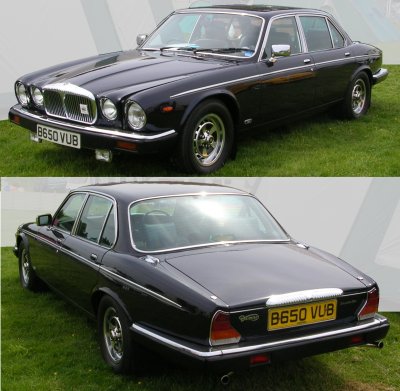
Daimler were also heavily involved in commercial vehicle manufacture, mainly buses, following the take over by Jaguar in 1957 the company bought Guy Motors Ltd (a noted commercial vehicle maker).
TVR (19??-12??, then bought by ???)
TVR Sports car photographed in 2007
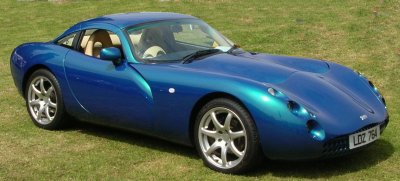
Star Motor Company(19??-1928 when bought by Guy (lorry manufacturers).
The Star range of vehicles was never very large, or terribly successful. The firm was taken over by Guy's in 1928, but production of Star motor cars ended in 1932.
Vauxhall (1903-1923, then bought by General Motors)
The Vauxhall Ironworks Co Ltd in Wandsworth Road, London, was set up to produce marine engines for river tugs by Alexander Wilson in 1857. In 1903 the first motor cars were built and in 1905 they moved the car manufacturing business to Luton. The American firm General Motors bought Vauxhall in 1928 to get themselves established in the British market. They expanded the plant at Luton and opened a second factory in Ellesmere Port. See also below for their history under General Motors ownership.
There have been many foreign companies building cars in Britain over the years, some achieving great success in the British market. From the 1970s there was n expansion of foreign car manufacturing in Britain as there were limits placed on the numbers of foreign built cars that could be sold within the European Economic Community (forerunner of the EU).
De Dion
Although French the De Dion was produced between 1899 and 1902 by a company at Mytholm, Hipperholme. The car used a 4 hp 2 horizontal cylinder Mytholm engine designed by R. Reynold-Jackson.Vauxhall (General Motors from 1928)
The Vauxhall Ironworks Co Ltd in Wandsworth Road, London, was set up to produce marine engines for river tugs by Alexander Wilson in 1857. In 1903 the first motor cars were built and in 1905 they moved the car manufacturing business to Luton. The American firm General Motors bought Vauxhall in 1928 to get themselves established in the British market. They expanded the plant at Luton and opened a second factory in Ellesmere Port.
Vauxhall Velox of 1955
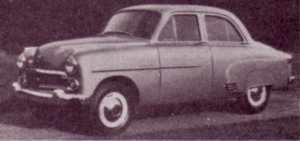
Vauxhall Victor Super from the later 1950s
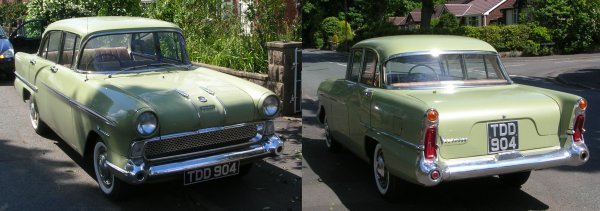
By the 1990s there had been a settling out and the market was divided into a series of categories catering to specific sub sections of the market. The small 'family hatchback' was probably the most common type on the roads with all manufacturers addressing this market. There had also been a great deal of legislation in place to make cars safer both for their occupants and also for other road users, the front and rear bumper were now soft plastic and the curve of the front of the car was designed to be less dangerous to pedestrians. The result was the 'jelly mould' shape which became very standardised and made it increasingly difficult to tell the difference between different makes of car.
Vauxhall Astra of the mid 1990s
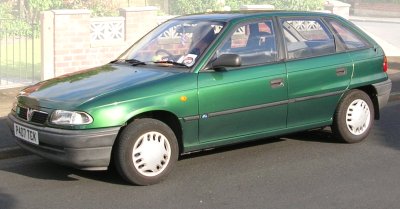
Ford
Fords established a British factory in 1928 building the Model T motor car using imported parts, these were painted blue until 1917 when Ford introduced an all-black policy (because the black paint was a better option than any of the coloured paints available at the time).
Ford Model T

Originally based alongside the A6 in Stockport (the factory is now a bicycle shop) they moved the Trafford Park in Manchester in the 1920s then in 1930 they built a huge factory in Dagenham in Essex. The Manchester factory closed after the Second World War.
Original British Ford Factory
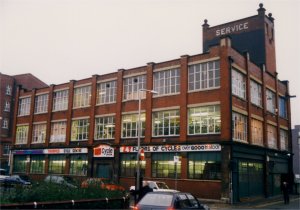
The Model A of 1926 (shown below) was another successful Ford car, built in both two seater (as shown) and four seater variants.
Ford Model A two seater of 1926
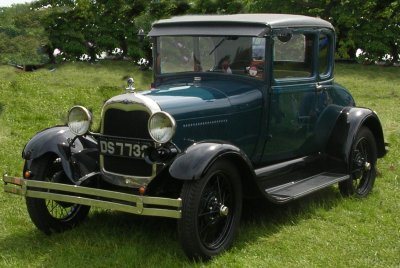
The requirements of the US and European markets evolved differently and Ford in the UK was very much a separate enterprise from the US Ford Motor Company, producing cars for the British and European markets. They also built commercial vehicles and tractors, sold under the Fordson brand.
The car shown below is the 1935 Ford Popular, scanned from a magazine advert of the period (courtesy Tim Whyte).
Ford Popular of 1935
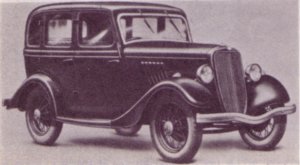
The 'Ford Pop' was a popular design that remained little changed in appearance until the 1950s, when the rear of cars changed from the bottom hinged vertical boot to the rear extension horizontal type.
The example shown below is the Ford 107E Prefect in production from 1959 to 1961, the 39 BHP engine offered a maximum speed of 76 MPH. These were only produced in De Luxe form, hence the two-tone paintwork.
Ford 107E Prefect
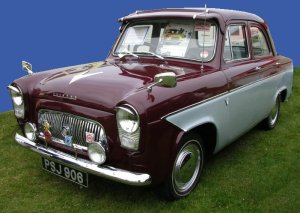
Ford Consul

In the 1960's the National Enterprise Board encouraged the building of factories for the new industries such as motor cars and chemicals, in areas where the decline of traditional industries, such as coal mining, had brought unemployment. This produced the so called 'development areas' and Ford's body and assembly plant at Halewood in Liverpool. The illustration below shows the popular Ford Cortina in its 1960s guise (left) and 1970s version (right).
Ford Cortina

The Ford Transit is built at their plant at Swaythling near Southampton. In 1986 Ford and Fiat merged their European commercial vehicle business to form Iveco.
Chrysler
Chrysler, a large American motor manufacturer, had an interest in several British companies and was building Dodge commercial vehicles in the UK from the 1920s on. In 1967 Chrysler gained full control of the Rootes Group (owner of marques such as Hillman, Humber, Sunbeam and Singer) and in 1970 the name changed to Chrysler UK Ltd although cars were still marketed as Hillman, Humber, Sunbeam and Singer.
Hillman Avenger early 1970s.

In 1976 the firm renamed its two branches as Chrysler (dealing with cars) and Dodge (dealing with trucks). Chrysler then sold off its European operation to the French Peugeot-Citroen group in 1978. Peugeot-Citroen group adopted the name Talbot for both cars and light commercials, the latter then being sold to Renault (who for a time sold the trucks badged as Dodge before switching to their own diamond logo). Commercial vehicle production came to an end in 1993.
Peugeot
Honda
Nissan